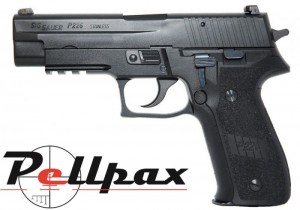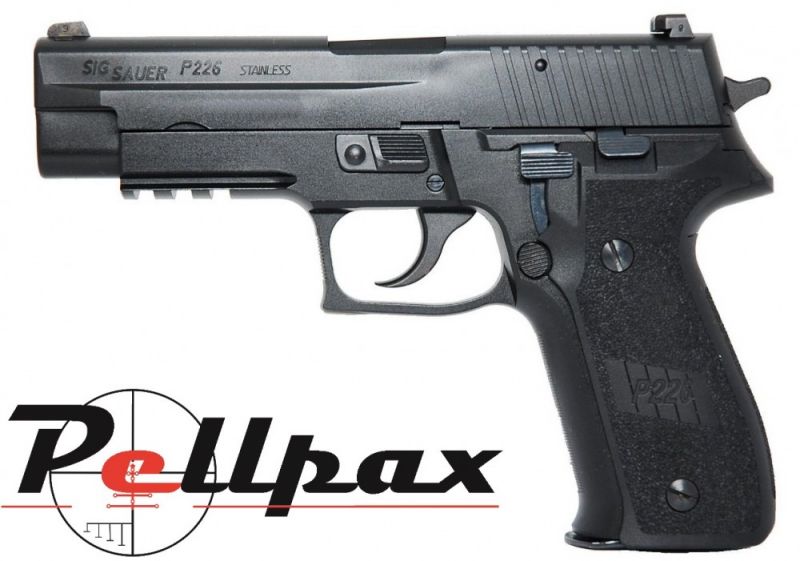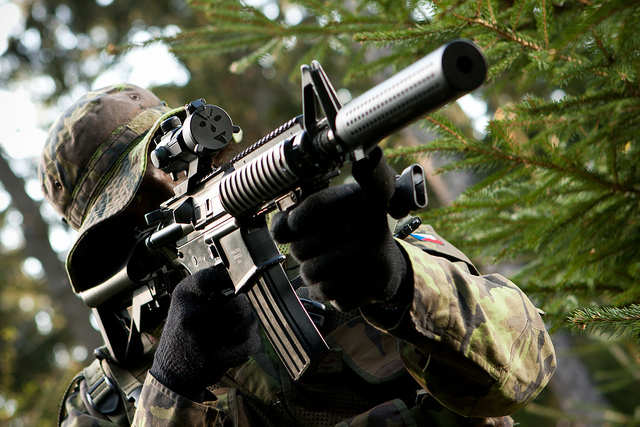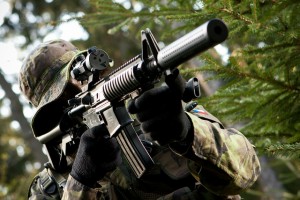 This month, Steph Brooks from the Pellpax team takes time out to review two highly prized mid-range airsoft pistols. Read on for more….
This month, Steph Brooks from the Pellpax team takes time out to review two highly prized mid-range airsoft pistols. Read on for more….
I’m taking a break from firearms this month, and reviewing two great bb guns in the shape of the KWC Desert Eagle and the Tokyo Marui Sig P226. Airsofting has become a major sporting activity, with sites springing up all over the country thanks to the large number of people willing to give up their weekends and evenings to skirmish though a boggy field or an abandoned industrial estate. With its growing popularity and thanks to the competitive nature of the activity, the best equipment is essential, so let’s try and decide between these two mid-priced pistols to help you get the edge over the competition.
Looks
In terms of appearance both of these pistols look very similar to their live firing counterparts. The Tokyo Marui P226 is more of a police/military style pistol whilst the Deagle has more of the Dirty Harry “Do you feel lucky punk?” factor and is certainly larger and more exiting to aim, feeling like it is capable of doing some real damage.
Both of these pistols feature an ABS plastic body with metal internals, such as the gas blow back system and magazine. This struck me as somewhat of a downside on the P226 where its smaller frame could surely support more of a full metal body and make this pistol feel more like the real thing. There are also noticeable mould lines around the P226 and whilst these are easily filed away, they make the pistol look more like a toy than a real firearm. The Desert Eagle already weighs nearly 2 kilos, so maybe a full metal construction would not be the best idea but I would have liked to have seen the classic chrome finish on the barrel and slide, to make it look more like its iconic live firing counterpart.
As I have stated before, to me, looks are nowhere near as important as how a gun handles or shoots but if had to pick a winner based on the appearance of these two I would go for the Desert Eagle thanks to its larger shape and construction. Both of these pistols look like bb guns and although the plastic is strong, I can’t help but feel that more metal would benefit the aesthetics of both these pistols.
Winner: KWC Desert Eagle
Operation
Both of these pistols operate with a gas blow back system which means that when fired the slide of the gun is pushed back by the gas and chambers the next bb for realistic operation and recoil. This does mean that some of the energy from the gas released is diverted away from the power required to propel the BBs out of the chamber. On other hand, does make these guns feel far more realistic than their static alternatives, with realistic recoil and kick.
The safety of the KWC is ambidextrous and easily accessible. It does lack that distinctive click clack engage/disengage noise but hey, it does the job. The P226 has a slide lock but lacks any safety switch of any kind which had me sometimes disengaging a safety that wasn’t there and at first, seemed somewhat of an over sight to me. However, after some research I discovered that the live firing version also lacks a manual safety switch, and can only be fired when the trigger is pulled thanks to some clever internal pin locks. I have been carrying the P226 in a holster all day and have never had it go off when I wasn’t expecting but would still prefer a manual safety switch. Maybe it’s a psychological thing, but with the KWC I know when that switch is engaged there is 0% chance of it firing, and with the P226 there was always a niggling thought in the back of my mind.
The P226 features a rail on its underside near the trigger guard, which is ideal for a laser or torch, and makes installation easy. The P226 is probably second only to the 1911 in terms of aftermarket accessories with springs, barrels, piston heads and body panels all available to tailor the pistol to suit your specific needs or desires. The KWC is without rails of any kind and its iron sights are not as precise or well-made as the P226, as they are without white dots or fibre optics which makes aiming, particularly at white targets, a tad trickier. The Desert Eagle also has nowhere near the same amount of options in terms extra parts.
The magazines of both pistols are relatively easy to fill with both bbs and gas with and thanks to their all metal construction both feel exceptional sturdy and lock into place with a satisfying clunk. The magazine of the KWC has a bit of lateral movement, but not much and certainly not enough to make feel as if the magazine was in any danger of falling out of position.
The grips of both pistols are made from stippled abs plastic and provide a sure hold, even under recoil, both in the naked hand and with airsofting gloves on. I would be interested to see if they are so easy to grip after a couple rounds in the rain or when coated in mud, but this will probably be more affected by your choice of gloves than the pistols themselves. The P226 fits the hand better but that is just generally a size issue, rather than shape or design. Not that the Deagle is too big or in any way cumbersome, but unless you are Andre the giant it is unlikely that you will be able to wrap you fingers all the way round it. The Desert Eagle is from the family of guns that perceive bigger as better, it is meant to feel powerful in your hands, but this does have a few drawbacks, and it is worth researching your holster before you buy it, as the Deagle will not fit into them all.
I think I’m gonna have to give this to the P226. Its lack of safety will take some getting used to, but the fact that it can reliably fit into any sized holster, and its extra customisation options make it more universally suitable.
Winner: Tokyo Marui P226
Performance
I tested both guns from a distance of 10 metres inside an indoor range to eliminate wind, temperature or elevation changes from effecting results, and first of all I have to say that both these bb guns are extremely fun to shoot. The P226 has got to be one of the loudest gas pistols I have ever fired. Some may see this as a disadvantage for giving away your position but I must admit, at the range it left a big smile on my face thinking “this thing hits hard”. The KWC features a slide that features strong feedback whenever the trigger is pulled which undoubtedly affects accuracy but makes this pistol feel like an absolute cannon which is, of course, extremely enjoyable. In reality both pistols shoot at around 300fps, but the KWC definitely feels the more powerful with its heavier recoil.
In terms of accuracy the P226 edges it with a grouping of around 2”, as always, ignoring a couple of outliers that were shot at the start of the magazine and were just me getting my eye in. Three of the holes were actually double taps and all shots landed within 1.5” of the bullseye. The Desert Eagle, ignoring a couple of outliers, grouped at around 2” also but with no double taps and a greater spread between the pellets, particularly in the vertical plane. This leads me to conclude that although both guns are comparable in terms of accuracy on the day, the P226 might just be the more consistent when it comes to hitting the target.
The trigger of the P226 features a long length of pull, a long reset and quite a sudden break, which does take a bit of getting used, to produce accurate results. The trigger action is consistent and doesn’t feel flimsy or unresponsive, it is just somewhat longer than I was expecting and I suspect that has something to do with the safety mechanism I mentioned earlier but, nonetheless I’m sure it won’t be for everyone. The trigger of the KWC is harder to pull but has a much shorter length, which makes the pistol seem more responsive.
Another thing to consider is that the P226 cycles much quicker than the Desert Eagle and I was able to empty the magazine far quicker when shooting with it. Part of this is down to the heavier kick of the Deagle taking longer to realign my aim after shooting, but even just blind firing the difference in speed is noticeable and something to consider if trying to aim at a moving target when your window of opportunity is small.
Despite having great fun with both of these pistols I think the winner has to be the P226. In terms of accuracy is was marginally more precise and the quicker cycling speed allows you to get your shot off when you need it.
Winner: Tokyo Marui P226
Conclusions
In summary, both of these pistols do an adequate job of being back up to your airsoft rifle or as a primary weapon in CQB engagements. Both pistols fire reliably and in my testing I encountered no problems with either of them. Both airsoft pistols are extremely fun to shoot and provide great feedback thanks to their gas blow back system. In terms of airsofting both of these pistols are accurate and reliable and can be drawn and fired in an instant and could give you the edge over the competition.
Since I have to pick a winner, I give it to the P226 because, despite its lack of safety and somewhat Marmite trigger, I found it to be more accurate and it offers a bigger range of extras if customisation is your thing.
Winner: Tokyo Marui P226
Head to the store where you can grab an airsoft Desert Eagle, a Tokyo Marui P226, or any from our huge range of airsoft pistols and airsoft rifles.
Check out Steph’s review of the Beretta CX-4 Storm Versus the Winchester Lever Action air rifles.



